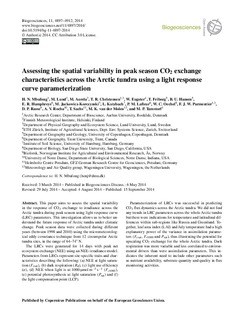| dc.contributor.author | Mbufong, Herbert N. | |
| dc.contributor.author | Lund, Magnus | |
| dc.contributor.author | Aurela, Mika | |
| dc.contributor.author | Christensen, Torben Röjle | |
| dc.contributor.author | Eugster, Werner | |
| dc.contributor.author | Friborg, Thomas | |
| dc.contributor.author | Hansen, Birger Ulf | |
| dc.contributor.author | Humphreys, Elyn R. | |
| dc.contributor.author | Jackowicz-Korczyński, Marcin | |
| dc.contributor.author | Kutzbach, Lars | |
| dc.contributor.author | Lafleur, Peter M. | |
| dc.contributor.author | Oechel, Walter C. | |
| dc.contributor.author | Parmentier, Frans-Jan W. | |
| dc.contributor.author | Rasse, Daniel | |
| dc.contributor.author | Rocha, A.V. | |
| dc.contributor.author | Sachs, Torsten | |
| dc.contributor.author | Van Der Molen, Michiel K. | |
| dc.contributor.author | Tamstorf, M.P. | |
| dc.date.accessioned | 2017-11-22T17:44:52Z | |
| dc.date.available | 2017-11-22T17:44:52Z | |
| dc.date.created | 2014-05-08T09:41:02Z | |
| dc.date.issued | 2014-09-15 | |
| dc.identifier.citation | Biogeosciences. 2014, 11 (17), 4897-4912. | nb_NO |
| dc.identifier.issn | 1726-4170 | |
| dc.identifier.uri | http://hdl.handle.net/11250/2467653 | |
| dc.description.abstract | This paper aims to assess the spatial variability in the response of CO2 exchange to irradiance across the Arctic tundra during peak season using light response curve (LRC) parameters. This investigation allows us to better understand the future response of Arctic tundra under climatic change. Peak season data were collected during different years (between 1998 and 2010) using the micrometeorological eddy covariance technique from 12 circumpolar Arctic tundra sites, in the range of 64–74° N.
The LRCs were generated for 14 days with peak net ecosystem exchange (NEE) using an NEE–irradiance model. Parameters from LRCs represent site-specific traits and characteristics describing the following: (a) NEE at light saturation (Fcsat), (b) dark respiration (Rd), (c) light use efficiency (α), (d) NEE when light is at 1000 μmol m−2 s−1 (Fc1000), (e) potential photosynthesis at light saturation (Psat) and (f) the light compensation point (LCP).
Parameterization of LRCs was successful in predicting CO2 flux dynamics across the Arctic tundra. We did not find any trends in LRC parameters across the whole Arctic tundra but there were indications for temperature and latitudinal differences within sub-regions like Russia and Greenland. Together, leaf area index (LAI) and July temperature had a high explanatory power of the variance in assimilation parameters (Fcsat, Fc1000 and Psat, thus illustrating the potential for upscaling CO2 exchange for the whole Arctic tundra. Dark respiration was more variable and less correlated to environmental drivers than were assimilation parameters. This indicates the inherent need to include other parameters such as nutrient availability, substrate quantity and quality in flux monitoring activities. | nb_NO |
| dc.language.iso | eng | nb_NO |
| dc.publisher | Copernicus Publications on behalf of the European Geosciences Union | nb_NO |
| dc.rights | Navngivelse 4.0 Internasjonal | * |
| dc.rights.uri | http://creativecommons.org/licenses/by/4.0/deed.no | * |
| dc.title | Assessing the spatial variability in peak season CO2 exchange characteristics across the Arctic tundra using a light response curve parameterization | nb_NO |
| dc.type | Journal article | nb_NO |
| dc.type | Peer reviewed | nb_NO |
| dc.description.version | publishedVersion | nb_NO |
| dc.rights.holder | © Author(s) 2014 | nb_NO |
| dc.source.pagenumber | 4897-4912 | nb_NO |
| dc.source.volume | 11 | nb_NO |
| dc.source.journal | Biogeosciences | nb_NO |
| dc.source.issue | 17 | nb_NO |
| dc.identifier.doi | 10.5194/bg-11-4897-2014 | |
| dc.identifier.cristin | 1131759 | |
| dc.relation.project | Norges forskningsråd: 208424 | nb_NO |
| cristin.ispublished | true | |
| cristin.fulltext | original | |
| cristin.qualitycode | 1 | |

